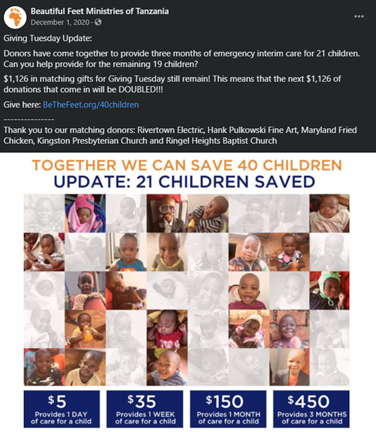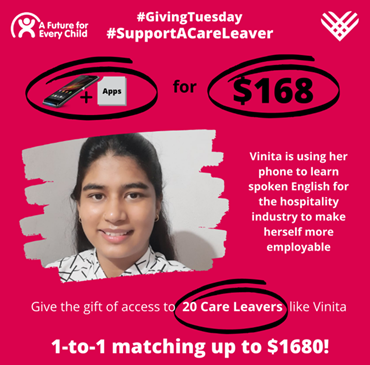
A matching gift is a great opportunity to leverage a generous donation from one donor – or a group of donors – to bring in even more money from other donors for your nonprofit.
Here’s how it works.
Let’s say you urgently need to replace 6 laptop computers for students in your program.
You mention to one of your best donors about the laptops and that replacing them isn’t in the budget, but it really needs to be done so the students can continue learning.
Like the loyal donor they are, they offer to help.
You then invite them to give $3,000 that can be used as a match as you raise money for the laptops. Of course, they say, “Yes!”
Their support lets you tell other donors: A generous donor has offered to match every gift made toward the laptops dollar-for-dollar up to $3,000! Double your donation right now!
Psychology comes into play here – as the supporter who might have scrolled by pauses, reads about the need, and gives $25, knowing their donation turns into $50 with the match.
Heck, they might even give $50 that turns into $100!
Before you know it, you’ve raised $3,000 to combine with the $3,000 match, and now you can easily buy your laptops.
You excitedly share with donors and your whole community that the goal has been reached. Yet you encourage donors to keep giving to cover even more technology needs for students. Maybe the donor will extend the match by another $1,000 (it can happen!).
It makes donors feel extra good to stretch their donation dollars. They care about your nonprofit’s work and they want to see you win. Turning a $50 donation into a $100 gift adds a little umph to the joy of giving!
A matching gift can work like magic to generate excitement and raise more money. So why doesn’t everybody leverage a matching gift with every campaign?
People are often confused about where to find matching gifts, afraid to make the ask, and uncertain how to maximize the matching gift to bring in the most money.
So, let’s break it down.
How to Find a Donor to Offer a Match
One of the main things that keeps people from launching matching gift campaigns is feeling like they don’t have anyone to pledge the initial match.
Maybe this is you, and you think “I don’t know any rich people. We don’t have any big donors, and no one on my Board will give that much.”
Whoa there partner, slow down! You probably DO have donors right now who would love to give you a bigger-than-normal gift to help you solve a specific problem like this. You just have to talk to them.
You see, getting a matching gift is easier than you think!
Start close to home with those most involved in your organization. Ask Board members if anyone would be willing to give the initial match. Break down what a matching gift is and why it works.
Most of your Board members will recognize the strategy, as it’s widely used, especially on Giving Tuesday. Many will have responded to another organization’s ask because of a match!
Your most likely prospect is a Board member who already gives a significant annual gift. Ask them to repurpose their annual gift as a matching gift, and then they’ll be stretching their dollars further.
If no one on your Board gives a large enough gift to offer as a full matching gift, ask Board members to pool their money. Set a goal of $5,000 and ask everyone to chip in toward that amount. Think of it as a matching gift fund.
Often, the generous donor offering a dollar-for-dollar match is actually donors (plural) – that is, several donors combining their gifts so they can power the organization to a successful campaign.
Once you ask Board members, expand your ask to other donors or volunteers who typically give a significant gift. Ask donors who have given $250 in the past to consider $500 toward the matching gift fund. If you have a donor who has given $500 in previous years, ask them to chip in $1,000.
Most of the time, people will say yes. They love that you took the time to talk to them personally and explain the need.
How to Ask For a Matching Gift
 When you ask a donor for a matching gift, make it a one-on-one, in-person conversation if possible.
When you ask a donor for a matching gift, make it a one-on-one, in-person conversation if possible.
If you can’t meet in person, ask over Zoom or schedule a phone call.
Treat the Ask like a big deal, even if the donor has made the same size gift in the past.
Remember that HOW you Ask matters. Keep your Ask focused on those you serve and the specific need you’re addressing.
Let the donor know they are valued by the organization. You are asking loyal donors to be part of a very special campaign. Share with the donor the reason for the campaign, the urgent need to raise the money.
- “We must raise $10,000 to move 4 more families out of shelters and into transitional housing. Our waiting list just keeps getting longer!”
- “We have to make repairs to our aging building, and we need $10,000 to replace the windows that are leaking. This repair can’t wait or the damage will be even worse and cost more to repair.”
- “We urgently need to raise $10,000 so we can continue our successful grocery gift card initiative and alleviate the stress of food insecurity for 10 families. Our feedback from families shows that this program has a stabilizing effect and gives them breathing room to seek ways to increase their income and get caught up on other bills.”
Emphasize that their gift will go further with the matching gift campaign. Every dollar they give will be doubled.
Assure the donor that you’re committed to making the most of the matching gift campaign. Share mockups of marketing materials and a sample calendar. Show the donor several examples of matching gift campaigns and let them know you would love for them to be the generous anonymous donor referenced in every matching gift campaign.
You are asking the donor to put up a significant amount of money, and in return you will do your part to market the campaign and wring as much value out of the matching gift as possible.
If you read the donor’s body language, you’ll know if they’re ready to say yes on the spot or if they need time to think it over. If you sense they need a little time, encourage the donor to think it over. Follow up with a note thanking the donor for the meeting. Let the donor know you will follow up in a week.
Then, follow up! If the answer is no, don’t sweat it. Move on to the next donor. If the answer is yes, congratulations!
When you get your first enthusiastic commitment, consider enlisting the donor to ask others. If your donor is a Board member, ask them to ask the other Board members to also give. They can say, “I’m really excited to be part of the matching fund for this matching gift campaign. I’d love for you to go in with me and make the matching fund even bigger.”
Whatever you do, don’t try to ask your donor for a match through email or text. That’s way too impersonal and doesn’t give the Ask the respect it needs.
If you’ve never asked for money in person before, this might be a bit intimidating. But you can do it! Remember that the donor prospect you’ve picked is someone who has already shown how much they care about your nonprofit’s work and those you serve. You’re just giving them the chance to do even more good.
Marketing Your Matching Gift – Appeal or Campaign?
A matching gift becomes an opportunity squandered if you don’t push out a successful marketing campaign.
In other words, you have to let people know, sharing it far and wide, that you have a matching gift and that you need others to give to solve the specific problem at hand.
Matching gift appeals work any time of year, but are particularly effective during the Fall. I’m sure you have seen plenty of matching gift campaigns on Giving Tuesday!
You can use a matching gift in a single appeal if you feel confident that you can raise what you need in a single Ask. Or you may need a matching gift campaign that stretches over more days, which is usually the case.
In planning a matching gift campaign, first set a start date and end date for the campaign. Two weeks is a good time-frame, and you can always extend the time if you need to.
If you’re planning your matching gift campaign to coincide with Giving Tuesday, have the campaign end actually on Giving Tuesday.
Don’t make the mistake of running a campaign that drags on too long because it can be exhausting for your donors. Plan carefully and give yourself time to meet the match – but not so much time that people get tired of hearing about it.
Some organizations have success with flash campaigns, offering a match but only within a tight time-frame, such as “within the next 48 hours!” Or “by midnight on Sunday!” This is a good strategy when the amount you’re trying to raise is small, and the need is urgent.
A matching gift campaign is designed to be marketed aggressively. Don’t be shy about spreading the word. You’re inviting people you know or who have worked with your organization in the past to make a donation, fund an urgent need, and receive the full match.
Word the Matching Gift Ask Carefully
 A successful matching gift campaign communicates the match as simply and clearly as possible: “A generous donor is matching dollar-for-dollar all donations received midnight on Sunday!”
A successful matching gift campaign communicates the match as simply and clearly as possible: “A generous donor is matching dollar-for-dollar all donations received midnight on Sunday!”
Always run the wording by the donor or donors to make sure you’re phrasing the Ask in a way that honors their intent.
Then focus on the need, just like you would for any Ask, answering these questions:
- Who will be helped?
- How will the money be used?
- Why is the money urgently needed?
Create eye-catching, branded social media graphics for your matching gift campaign on Canva or a similar tool. Create a different graphic for every day of the campaign, but keep the overall look of the graphics the same.
In all graphics, describe the match in the simplest of terms: You give a dollar, a generous donor matches the dollar. Share different stories and details each day to keep the campaign fresh.
Don’t limit your campaign to Facebook. Use email marketing and other social channels to get the word out. Ask your Board, volunteers, and core supporters to send the campaign to their friends and family members with a personal note about why they support this organization and campaign.


The Logistics of a Matching Gift Campaign
Be ready to pull out all the stops with your matching gift campaign because the day after the campaign, it’s time to request funds from the donor(s) who pledged the initial match but only in the amount you raised during the campaign.
This is what a matching gift is after all – a gift you only get if you get other donors to give as well!
Some donors may donate the full amount regardless of what you raise, and that’s great. But they shouldn’t feel pressured to do so.
All the language around the matching gift campaign should specify that the donor will follow through on the amount raised by donors up to the match the donor offered.
Thank the donor(s) profusely for putting up the initial match and making the campaign successful. If you fall short of raising the amount for the full match, don’t dwell on it. Focus on the money you did raise and how much good you’ll be able to do with it.
Report back to ALL donors to let them know the campaign was successful. This gives people the sense of satisfaction that they were part of something successful.
One final note about closing out a match campaign. Some donors will want to make their donation at the end of the year. This is normal for many people making major gifts. Let the donor know this is fine. Make a note to remind the donor in December to fulfill their match pledge.
Other Types of Matches
There are a few other ways to use matching gift psychology to inspire donors to give.
 1. Triple your donation. To compete with the many dollar-for-dollar matching gift campaigns out there, some organizations promise to triple your donation with a gift from a generous donor. In this case, if the matching gift fund is $9,000 instead of $3,000, you could tell donors that every gift will be tripled.
1. Triple your donation. To compete with the many dollar-for-dollar matching gift campaigns out there, some organizations promise to triple your donation with a gift from a generous donor. In this case, if the matching gift fund is $9,000 instead of $3,000, you could tell donors that every gift will be tripled.
Because you only need to bring in $3,000 to meet the match, you can set yourself up for a high chance of success and continue the campaign even after the match has been met. Remember, donors like to be part of something successful!
Studies have suggested that there is no psychological benefit to tripling the donation versus doubling the donation. But organizations do it to help their campaign stand out from the pack, which can be hard to do, especially on Giving Tuesday.
2. Challenge grant. A challenge grant is different from a matching gift, but the language is similar. A foundation, company, or donor offers a significant amount and pledges to write the check after the organization raises the same amount.
For example, let’s say you land a six-figure challenge grant for a capital project. Then you can tell your supporters, “A foundation has generously offered a challenge grant of $250,000. If we raise $250,000 from our supporters by December 31, the donor will write a check for $250,000! It’s that simple! Please give now to help us complete our new shelter.”
Now the pressure is on to raise that $250,000. It’s all hands on deck for a strategic campaign that’ll succeed within the time-frame agreed upon by the donor and the organization.
3. Monthly donor match. A match campaign can be a fantastic way to grow your monthly donor program. Recruit a donor to offer $100 for every new monthly donor who signs up for at least $20 a month. If the donor is willing to put up $5,000 to grow the monthly donor program by 50 donors, their investment will really pay off over the long haul! That’s at least $1,000 a month … indefinitely. That’s $12,000 a year, at least!
Your language might read, “We’re on a quest to welcome 50 new supporters to our monthly donor program, which ensures we have the money we need each month to provide pet food and veterinary care to our neighbors who cannot afford to take care of their pets right now. A generous donor is giving us $100 for every new monthly donor who signs up by midnight on Friday for a monthly gift of at least $20. By signing up 50 new monthly donors, we’ll receive a one-time gift of $5,000!”
The Bottom Line
A matching gift is a winning fundraising strategy. It taps into the psychology of donors and their desire to maximize their capacity to give. Whatever they give, even if it’s a small amount, becomes something more and does more good.
Even though this is a widely used and proven strategy, some organizations are reluctant to get on board. Commit to trying a matching gift campaign if you’ve never done one. You can start small with just a $1,000 match. Get 4 donors to kick in $250, and then run the campaign and see how it goes.
Matching gift campaigns will not fund all your needs, but for most organizations, they can be one slice of your fundraising pie, a slice that leaves donors feeling motivated and inspired, regardless of how much they have to give.
Additional Resources
If you’re a Fundraising TV subscriber, catch the episode on “Find and Use a Matching Gift to Raise More Money.” Not a subscriber? Learn more here: www.GetFullyFunded.com/TV








Leave A Comment